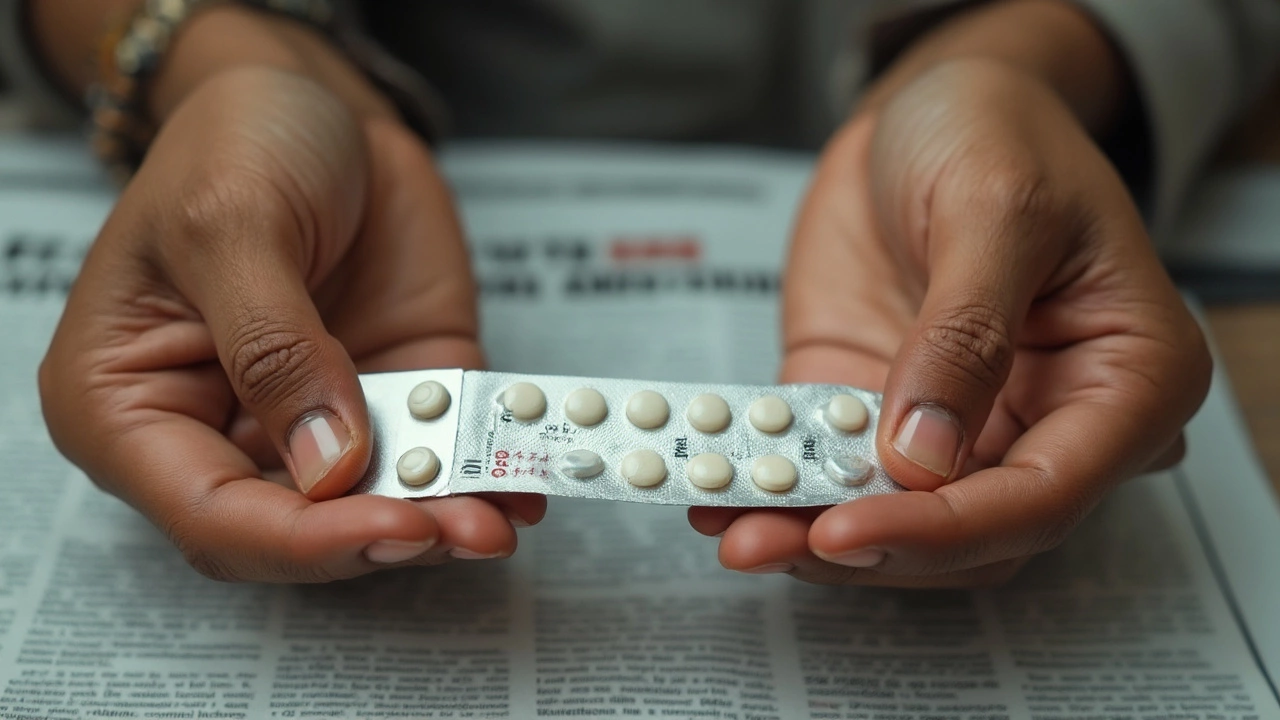Search 'why is metformin banned in America' and you'll see panic posts, angry tweets, and even conspiracy theories. Spoiler alert: Metformin is not banned in the U.S. It’s actually one of the most prescribed drugs for type 2 diabetes. So why are so many people confused?
The buzz mostly started in 2020 when the FDA found traces of NDMA, a possible cancer-causing impurity, in some batches of metformin. Headlines blared about recalls, and pretty soon, word-of-mouth turned 'recalls' into 'bans.' But a recall means only certain products got pulled because of safety checks, not that the drug itself is outlawed.
Don’t let internet rumors make you ditch your meds. Stick with what your doctor says, and check in with your pharmacist if you’re worried about which brand you have. A lot of people rely on metformin every day without problems. The real story is less dramatic but way more useful if you want to stay healthy and out of trouble with your prescriptions.
- Where Did the Metformin Ban Rumor Start?
- The Real Story: Metformin Recalls and NDMA
- FDA Actions and Recommendations
- Should You Worry About Taking Metformin?
- Alternative Diabetes Medications
- Tips for Staying Safe With Prescriptions
Where Did the Metformin Ban Rumor Start?
This whole mess started when people saw headlines about metformin recalls, not an actual metformin ban in America. The alarm first went off in late 2019, when independent labs found small amounts of NDMA—a chemical that might cause cancer—in certain extended-release forms of metformin. Not all batches were affected, just a handful of them from specific companies. But the story blew up fast online.
Instead of reading the details, people just heard "recall" and thought "ban." Social media did the rest, spreading the word way faster than any official health source could keep up. Within weeks, people were panicking and posting messages like, "My pharmacy says I can't get my metformin! Has it been banned?!" News sites got clicks by running with scary headlines, even though the FDA was clear: only some versions were being recalled, not the whole drug.
Here’s a quick breakdown of the timeline when everything got heated:
| Date | Event |
|---|---|
| December 2019 | First NDMA findings in foreign metformin products |
| February 2020 | Independent U.S. lab finds NDMA in certain extended-release metformin |
| May 2020 | FDA officially requests recalls from specific companies |
| June 2020 | Widespread news coverage and social media panic |
Even after the FDA and pharmacies explained what happened, the internet kept echoing the myth that metformin itself was yanked from the shelves. Turns out, misinformation spreads faster than facts, especially when it comes to something as personal as diabetes medication.
If you’re scrolling TikTok or Facebook and see someone say, “stop taking metformin, it’s banned,” remember: fact-check it through a real medical source or ask your doctor.
The Real Story: Metformin Recalls and NDMA
This whole mess around metformin started in late 2019 and 2020, when the FDA and other agencies started testing a bunch of drugs for NDMA. So, what the heck is NDMA? It's a chemical that can show up as a tiny impurity when certain drugs are made. In big amounts, it’s been linked to cancer. The main worry was that long-term use of pills with too much NDMA might put people at risk.
Some batches of metformin—mostly the extended-release (ER) type—were found to have more NDMA than the FDA says is okay. Now, here’s where people got confused: instead of banning all metformin, the FDA told certain drug companies to recall specific lots, mostly in 2020. If you saw a post screaming about a ‘ban,’ it was probably mixing up ‘recall’ and ‘ban.’
Here’s a quick look at what happened with metformin recalls:
| Date | Action | Notes |
|---|---|---|
| May 2020 | First recalls announced | Several companies pulled ER metformin off shelves due to higher NDMA levels |
| June-July 2020 | More recalls | Extra lots from other companies recalled |
| Late 2020 | Testing continues | Immediate-release metformin mostly unaffected |
The whole point was to keep folks safe, not to yank metformin away from everyone with diabetes. Most pharmacies switched patients over to brands or batches that were cleared by the FDA. If you use metformin, especially the ER version, it’s smart to check with your pharmacist if your pills are from a problem lot. You can also find the list of recalled brands right on the FDA website.
If you want to play it extra safe, hold onto your medication packaging. That info can help a pharmacist double-check if you need a swap. And just so you know, NDMA can be found in other stuff too, like cured meats and even drinking water—so the risk from metformin was about long-term, daily exposure from bad batches, not a single dose.
FDA Actions and Recommendations
When the FDA caught wind that certain lots of metformin could have NDMA, they didn’t just sit around. In early 2020, the agency told manufacturers to test all extended-release metformin and later expanded that to immediate-release forms. If tests showed NDMA at levels above what they consider safe, those batches got recalled fast. The goal wasn’t to scare people but to make sure nobody’s daily medicine included even a tiny bit of something potentially risky.
The FDA made it clear: do not stop metformin cold turkey because of what you see online. Stopping suddenly can seriously mess with your blood sugar. They told doctors to keep patients on their meds unless there was a recall directly affecting their prescription. Pharmacies pulled the affected brands and offered substitutes that passed all safety checks, so folks didn’t have to skip a beat.
What’s the bottom line for patients? The FDA recommends:
- Keep taking metformin unless your pharmacist or doctor tells you otherwise.
- Check the label on your bottle if you’re worried—pharmacists know which lots were recalled.
- If your brand is part of a recall, your pharmacy should swap out your meds with a safe version. Don’t just throw your pills away until you have a replacement.
The FDA updates safety alerts and recall info on their official website, so you can always check for yourself whether your batch is impacted. They’re not about flashy headlines—they just want your medication to be as safe as it should be.

Should You Worry About Taking Metformin?
If you’re taking metformin, it’s normal to feel nervous after hearing stories about recalls and contamination. Here’s what you should actually know: the metformin ban rumors don’t match what’s happening in real life. Metformin is still widely prescribed in the U.S. and the FDA considers it safe for most people.
The recall in 2020 happened because a few brands of extended-release versions had NDMA (a potential carcinogen) a bit above the latest safety limit. Immediate-release (the most common type) wasn’t much of an issue. Brands that failed the quality checks were pulled, but the medication itself didn’t disappear from pharmacies. Here’s a quick breakdown:
| Type | Status after 2020 Recall | Reason for Concern |
|---|---|---|
| Metformin (Immediate-Release) | Still available | Little or no NDMA risk |
| Metformin (Extended-Release) | Some brands recalled | NDMA found in select batches |
Doctors and the FDA agree: don’t stop taking metformin unless your doctor says so. Skipping doses could seriously mess with your blood sugar. Major medical groups still support using metformin as a go-to for type 2 diabetes. If you’re worried or have a recalled batch, just ask your pharmacist for a swap – there are plenty of safe options.
- Check your prescription bottle for the manufacturer’s name.
- If you hear about a recall, visit the FDA website or talk to your pharmacist to see if you’re affected.
- Notice weird side effects? Bring them up with your healthcare provider right away.
Honestly, if you’re using a pharmacy that stays updated on recalls (most big chains do), you’re probably safe. Plus, the FDA keeps a running list of any changes, so you can always double-check. No need to panic—just stay alert and keep in touch with your healthcare team.
Alternative Diabetes Medications
If your doctor says you can’t take metformin or you’ve had issues with recalls, you’ve still got plenty of other diabetes meds to consider. These days, doctors have a good list of backup options, and they usually pick what fits your health profile and lifestyle best. Here’s a straightforward look at some alternatives for managing type 2 diabetes.
- SGLT2 Inhibitors: These include meds like empagliflozin (Jardiance) and dapagliflozin (Farxiga). They help your kidneys flush more sugar out in your urine. Some people like these because they often help with weight loss and lower the risk of heart issues.
- GLP-1 Receptor Agonists: Maybe you’ve heard of Ozempic or Trulicity. These work by making you feel full and slowing down stomach emptying. They can help lose a few extra pounds, and research shows they protect the heart too.
- Sulfonylureas: Pills like glipizide or glyburide help your body pump out more insulin. They’re old-school but still work for some people, though you need to watch for low blood sugar.
- DPP-4 Inhibitors: Think Januvia or Tradjenta. They’re less likely to cause low blood sugar and work by helping your body use insulin better after meals.
- Insulin: A lot of folks jump straight to shots, but most people aren’t put on insulin unless other meds stop working or their blood sugar is really out of control. Insulin is actually pretty straightforward once you get the hang of it.
If you want to compare the main alternatives side by side, check out this chart:
| Medication Type | Common Brands | Main Benefit | Main Risk/Side Effect |
|---|---|---|---|
| SGLT2 Inhibitors | Jardiance, Farxiga | Heart protection, weight loss | Urinary infections |
| GLP-1 Agonists | Ozempic, Trulicity | Weight loss, heart protection | Nausea, stomach issues |
| Sulfonylureas | Glipizide, Glyburide | Cost effective, lowers sugar | Low blood sugar (hypoglycemia) |
| DPP-4 Inhibitors | Januvia, Tradjenta | Easy to take, mild side effects | Joint pain, rare pancreatitis |
| Insulin | Lantus, Humalog | Works when others fail | Low blood sugar, weight gain |
Most insurance plans cover at least a few of these options, but prices can shoot up for brand-name drugs. Don’t be afraid to ask your doctor about generics or samples—they hand them out more often than you think. When you’re switching meds, keep a log of your blood sugars and watch out for any weird side effects. If anything feels off, call your doctor for advice.
No one-size-fits-all fix exists in diabetes treatment, so work with your health team to find what really works for you. And never go cold turkey on your meds—suddenly stopping can mess up your blood sugar big time, so always have a plan with your doc.
The world of diabetes medication is a lot bigger than people realize. With newer treatments, you’ve got more ways than ever to keep your blood sugar in check, even if metformin is off the table.
Tips for Staying Safe With Prescriptions
When it comes to diabetes meds like metformin, being smart about your prescriptions can actually save you a ton of worry (and probably a few headaches). Here’s what you can do, step by step, to keep yourself safe and get the most out of your medication.
- Check your pills and packaging regularly. Glance at the pill color, shape, and markings every time you refill. If something looks off compared to last time, let your pharmacist know. Rare mix-ups do happen.
- Ask your pharmacist about recalls. The FDA lists recalls on their website, but let's face it, most people don’t read government bulletins. A quick, “Has my metformin been recalled lately?” when you pick up your meds gives you peace of mind. If your batch is flagged, your pharmacy can swap it out.
- Watch for odd symptoms. New rashes, tummy problems, or weird fatigue after starting a new bottle? Don’t ignore it. Report new or worsening side effects to your doctor ASAP, especially if you just switched brands.
- Only use trusted pharmacies. Big chain pharmacies and local pharmacies with good reputations are your best bet. Avoid mail-order suppliers that seem sketchy—counterfeits do exist.
- Don’t tinker with your meds. No slicing tablets, changing doses, or skipping days on your own. Even swapping brands randomly can cause problems, as formulations vary slightly between manufacturers.
- Keep an updated medication list. Write down what you take and bring it to appointments. If your meds change or get recalled, this helps your healthcare provider sort everything out fast.
You can also sign up for text or app alerts from your pharmacy. This way, you’ll get instant heads up if there’s a recall that affects you. And if you’re ever unsure, picking up the phone and calling your pharmacist is always a good move—they deal with this stuff every day.
Bottom line: Your safety comes first. Taking a few quick steps when you refill your prescription or hear about a drug scare keeps your treatment on track and your stress in check.








